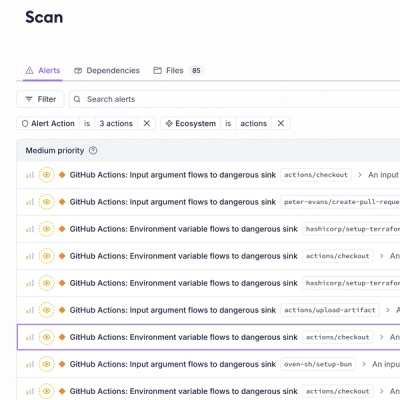
Product
Introducing Socket Firewall Enterprise: Flexible, Configurable Protection for Modern Package Ecosystems
Socket Firewall Enterprise is now available with flexible deployment, configurable policies, and expanded language support.
@maxim_mazurok/gapi.client.securitycenter-v1beta2
Advanced tools
TypeScript typings for Security Command Center API v1beta2
Security Command Center API provides access to temporal views of assets and findings within an organization. For detailed description please check documentation.
Install typings for Security Command Center API:
npm install @types/gapi.client.securitycenter-v1beta2 --save-dev
You need to initialize Google API client in your code:
gapi.load('client', () => {
// now we can use gapi.client
// ...
});
Then load api client wrapper:
gapi.client.load(
'https://securitycenter.googleapis.com/$discovery/rest?version=v1beta2',
() => {
// now we can use:
// gapi.client.securitycenter
}
);
// Deprecated, use discovery document URL, see https://github.com/google/google-api-javascript-client/blob/master/docs/reference.md#----gapiclientloadname----version----callback--
gapi.client.load('securitycenter', 'v1beta2', () => {
// now we can use:
// gapi.client.securitycenter
});
Don't forget to authenticate your client before sending any request to resources:
// declare client_id registered in Google Developers Console
var client_id = '',
scope = [
// See, edit, configure, and delete your Google Cloud data and see the email address for your Google Account.
'https://www.googleapis.com/auth/cloud-platform',
],
immediate = true;
// ...
gapi.auth.authorize(
{client_id: client_id, scope: scope, immediate: immediate},
authResult => {
if (authResult && !authResult.error) {
/* handle successful authorization */
} else {
/* handle authorization error */
}
}
);
After that you can use Security Command Center API resources:
/*
Get the ContainerThreatDetectionSettings resource. In the returned settings response, a missing field only indicates that it was not explicitly set, so no assumption should be made about these fields. In other words, GetContainerThreatDetectionSettings does not calculate the effective service settings for the resource, which accounts for inherited settings and defaults. Instead, use CalculateContainerThreatDetectionSettings for this purpose.
*/
await gapi.client.securitycenter.folders.getContainerThreatDetectionSettings({
name: 'name',
});
/*
Get the EventThreatDetectionSettings resource. In the returned settings response, a missing field only indicates that it was not explicitly set, so no assumption should be made about these fields. In other words, GetEventThreatDetectionSettings does not calculate the effective service settings for the resource, which accounts for inherited settings and defaults. Instead, use CalculateEventThreatDetectionSettings for this purpose.
*/
await gapi.client.securitycenter.folders.getEventThreatDetectionSettings({
name: 'name',
});
/*
Get the RapidVulnerabilityDetectionSettings resource. In the returned settings response, a missing field only indicates that it was not explicitly set, so no assumption should be made about these fields. In other words, GetRapidVulnerabilityDetectionSettings does not calculate the effective service settings for the resource, which accounts for inherited settings and defaults. Instead, use CalculateRapidVulnerabilityDetectionSettings for this purpose.
*/
await gapi.client.securitycenter.folders.getRapidVulnerabilityDetectionSettings(
{name: 'name'}
);
/*
Get the SecurityCenterSettings resource.
*/
await gapi.client.securitycenter.folders.getSecurityCenterSettings({
name: 'name',
});
/*
Get the SecurityHealthAnalyticsSettings resource. In the returned settings response, a missing field only indicates that it was not explicitly set, so no assumption should be made about these fields. In other words, GetSecurityHealthAnalyticsSettings does not calculate the effective service settings for the resource, which accounts for inherited settings and defaults. Instead, use CalculateSecurityHealthAnalyticsSettings for this purpose.
*/
await gapi.client.securitycenter.folders.getSecurityHealthAnalyticsSettings({
name: 'name',
});
/*
Get the VirtualMachineThreatDetectionSettings resource. In the returned settings response, a missing field only indicates that it was not explicitly set, so no assumption should be made about these fields. In other words, GetVirtualMachineThreatDetectionSettings does not calculate the effective service settings for the resource, which accounts for inherited settings and defaults. Instead, use CalculateVirtualMachineThreatDetectionSettings for this purpose.
*/
await gapi.client.securitycenter.folders.getVirtualMachineThreatDetectionSettings(
{name: 'name'}
);
/*
Get the WebSecurityScannerSettings resource. In the returned settings response, a missing field only indicates that it was not explicitly set, so no assumption should be made about these fields. In other words, GetWebSecurityScannerSettings does not calculate the effective service settings for the resource, which accounts for inherited settings and defaults. Instead, use CalculateWebSecurityScannerSettings for this purpose.
*/
await gapi.client.securitycenter.folders.getWebSecurityScannerSettings({
name: 'name',
});
/*
Update the ContainerThreatDetectionSettings resource.
*/
await gapi.client.securitycenter.folders.updateContainerThreatDetectionSettings(
{name: 'name'}
);
/*
Update the EventThreatDetectionSettings resource.
*/
await gapi.client.securitycenter.folders.updateEventThreatDetectionSettings({
name: 'name',
});
/*
Update the RapidVulnerabilityDetectionSettings resource.
*/
await gapi.client.securitycenter.folders.updateRapidVulnerabilityDetectionSettings(
{name: 'name'}
);
/*
Update the SecurityHealthAnalyticsSettings resource.
*/
await gapi.client.securitycenter.folders.updateSecurityHealthAnalyticsSettings({
name: 'name',
});
/*
Update the VirtualMachineThreatDetectionSettings resource.
*/
await gapi.client.securitycenter.folders.updateVirtualMachineThreatDetectionSettings(
{name: 'name'}
);
/*
Update the WebSecurityScannerSettings resource.
*/
await gapi.client.securitycenter.folders.updateWebSecurityScannerSettings({
name: 'name',
});
/*
Get the ContainerThreatDetectionSettings resource. In the returned settings response, a missing field only indicates that it was not explicitly set, so no assumption should be made about these fields. In other words, GetContainerThreatDetectionSettings does not calculate the effective service settings for the resource, which accounts for inherited settings and defaults. Instead, use CalculateContainerThreatDetectionSettings for this purpose.
*/
await gapi.client.securitycenter.organizations.getContainerThreatDetectionSettings(
{name: 'name'}
);
/*
Get the EventThreatDetectionSettings resource. In the returned settings response, a missing field only indicates that it was not explicitly set, so no assumption should be made about these fields. In other words, GetEventThreatDetectionSettings does not calculate the effective service settings for the resource, which accounts for inherited settings and defaults. Instead, use CalculateEventThreatDetectionSettings for this purpose.
*/
await gapi.client.securitycenter.organizations.getEventThreatDetectionSettings({
name: 'name',
});
/*
Get the RapidVulnerabilityDetectionSettings resource. In the returned settings response, a missing field only indicates that it was not explicitly set, so no assumption should be made about these fields. In other words, GetRapidVulnerabilityDetectionSettings does not calculate the effective service settings for the resource, which accounts for inherited settings and defaults. Instead, use CalculateRapidVulnerabilityDetectionSettings for this purpose.
*/
await gapi.client.securitycenter.organizations.getRapidVulnerabilityDetectionSettings(
{name: 'name'}
);
/*
Get the SecurityCenterSettings resource.
*/
await gapi.client.securitycenter.organizations.getSecurityCenterSettings({
name: 'name',
});
/*
Get the SecurityHealthAnalyticsSettings resource. In the returned settings response, a missing field only indicates that it was not explicitly set, so no assumption should be made about these fields. In other words, GetSecurityHealthAnalyticsSettings does not calculate the effective service settings for the resource, which accounts for inherited settings and defaults. Instead, use CalculateSecurityHealthAnalyticsSettings for this purpose.
*/
await gapi.client.securitycenter.organizations.getSecurityHealthAnalyticsSettings(
{name: 'name'}
);
/*
Get the Subscription resource.
*/
await gapi.client.securitycenter.organizations.getSubscription({name: 'name'});
/*
Get the VirtualMachineThreatDetectionSettings resource. In the returned settings response, a missing field only indicates that it was not explicitly set, so no assumption should be made about these fields. In other words, GetVirtualMachineThreatDetectionSettings does not calculate the effective service settings for the resource, which accounts for inherited settings and defaults. Instead, use CalculateVirtualMachineThreatDetectionSettings for this purpose.
*/
await gapi.client.securitycenter.organizations.getVirtualMachineThreatDetectionSettings(
{name: 'name'}
);
/*
Get the WebSecurityScannerSettings resource. In the returned settings response, a missing field only indicates that it was not explicitly set, so no assumption should be made about these fields. In other words, GetWebSecurityScannerSettings does not calculate the effective service settings for the resource, which accounts for inherited settings and defaults. Instead, use CalculateWebSecurityScannerSettings for this purpose.
*/
await gapi.client.securitycenter.organizations.getWebSecurityScannerSettings({
name: 'name',
});
/*
Update the ContainerThreatDetectionSettings resource.
*/
await gapi.client.securitycenter.organizations.updateContainerThreatDetectionSettings(
{name: 'name'}
);
/*
Update the EventThreatDetectionSettings resource.
*/
await gapi.client.securitycenter.organizations.updateEventThreatDetectionSettings(
{name: 'name'}
);
/*
Update the RapidVulnerabilityDetectionSettings resource.
*/
await gapi.client.securitycenter.organizations.updateRapidVulnerabilityDetectionSettings(
{name: 'name'}
);
/*
Update the SecurityHealthAnalyticsSettings resource.
*/
await gapi.client.securitycenter.organizations.updateSecurityHealthAnalyticsSettings(
{name: 'name'}
);
/*
Update the VirtualMachineThreatDetectionSettings resource.
*/
await gapi.client.securitycenter.organizations.updateVirtualMachineThreatDetectionSettings(
{name: 'name'}
);
/*
Update the WebSecurityScannerSettings resource.
*/
await gapi.client.securitycenter.organizations.updateWebSecurityScannerSettings(
{name: 'name'}
);
/*
Get the ContainerThreatDetectionSettings resource. In the returned settings response, a missing field only indicates that it was not explicitly set, so no assumption should be made about these fields. In other words, GetContainerThreatDetectionSettings does not calculate the effective service settings for the resource, which accounts for inherited settings and defaults. Instead, use CalculateContainerThreatDetectionSettings for this purpose.
*/
await gapi.client.securitycenter.projects.getContainerThreatDetectionSettings({
name: 'name',
});
/*
Get the EventThreatDetectionSettings resource. In the returned settings response, a missing field only indicates that it was not explicitly set, so no assumption should be made about these fields. In other words, GetEventThreatDetectionSettings does not calculate the effective service settings for the resource, which accounts for inherited settings and defaults. Instead, use CalculateEventThreatDetectionSettings for this purpose.
*/
await gapi.client.securitycenter.projects.getEventThreatDetectionSettings({
name: 'name',
});
/*
Get the RapidVulnerabilityDetectionSettings resource. In the returned settings response, a missing field only indicates that it was not explicitly set, so no assumption should be made about these fields. In other words, GetRapidVulnerabilityDetectionSettings does not calculate the effective service settings for the resource, which accounts for inherited settings and defaults. Instead, use CalculateRapidVulnerabilityDetectionSettings for this purpose.
*/
await gapi.client.securitycenter.projects.getRapidVulnerabilityDetectionSettings(
{name: 'name'}
);
/*
Get the SecurityCenterSettings resource.
*/
await gapi.client.securitycenter.projects.getSecurityCenterSettings({
name: 'name',
});
/*
Get the SecurityHealthAnalyticsSettings resource. In the returned settings response, a missing field only indicates that it was not explicitly set, so no assumption should be made about these fields. In other words, GetSecurityHealthAnalyticsSettings does not calculate the effective service settings for the resource, which accounts for inherited settings and defaults. Instead, use CalculateSecurityHealthAnalyticsSettings for this purpose.
*/
await gapi.client.securitycenter.projects.getSecurityHealthAnalyticsSettings({
name: 'name',
});
/*
Get the VirtualMachineThreatDetectionSettings resource. In the returned settings response, a missing field only indicates that it was not explicitly set, so no assumption should be made about these fields. In other words, GetVirtualMachineThreatDetectionSettings does not calculate the effective service settings for the resource, which accounts for inherited settings and defaults. Instead, use CalculateVirtualMachineThreatDetectionSettings for this purpose.
*/
await gapi.client.securitycenter.projects.getVirtualMachineThreatDetectionSettings(
{name: 'name'}
);
/*
Get the WebSecurityScannerSettings resource. In the returned settings response, a missing field only indicates that it was not explicitly set, so no assumption should be made about these fields. In other words, GetWebSecurityScannerSettings does not calculate the effective service settings for the resource, which accounts for inherited settings and defaults. Instead, use CalculateWebSecurityScannerSettings for this purpose.
*/
await gapi.client.securitycenter.projects.getWebSecurityScannerSettings({
name: 'name',
});
/*
Update the ContainerThreatDetectionSettings resource.
*/
await gapi.client.securitycenter.projects.updateContainerThreatDetectionSettings(
{name: 'name'}
);
/*
Update the EventThreatDetectionSettings resource.
*/
await gapi.client.securitycenter.projects.updateEventThreatDetectionSettings({
name: 'name',
});
/*
Update the RapidVulnerabilityDetectionSettings resource.
*/
await gapi.client.securitycenter.projects.updateRapidVulnerabilityDetectionSettings(
{name: 'name'}
);
/*
Update the SecurityHealthAnalyticsSettings resource.
*/
await gapi.client.securitycenter.projects.updateSecurityHealthAnalyticsSettings(
{name: 'name'}
);
/*
Update the VirtualMachineThreatDetectionSettings resource.
*/
await gapi.client.securitycenter.projects.updateVirtualMachineThreatDetectionSettings(
{name: 'name'}
);
/*
Update the WebSecurityScannerSettings resource.
*/
await gapi.client.securitycenter.projects.updateWebSecurityScannerSettings({
name: 'name',
});
FAQs
TypeScript typings for Security Command Center API v1beta2
The npm package @maxim_mazurok/gapi.client.securitycenter-v1beta2 receives a total of 435 weekly downloads. As such, @maxim_mazurok/gapi.client.securitycenter-v1beta2 popularity was classified as not popular.
We found that @maxim_mazurok/gapi.client.securitycenter-v1beta2 demonstrated a healthy version release cadence and project activity because the last version was released less than a year ago. It has 1 open source maintainer collaborating on the project.
Did you know?

Socket for GitHub automatically highlights issues in each pull request and monitors the health of all your open source dependencies. Discover the contents of your packages and block harmful activity before you install or update your dependencies.

Product
Socket Firewall Enterprise is now available with flexible deployment, configurable policies, and expanded language support.

Security News
Open source dashboard CNAPulse tracks CVE Numbering Authorities’ publishing activity, highlighting trends and transparency across the CVE ecosystem.

Product
Detect malware, unsafe data flows, and license issues in GitHub Actions with Socket’s new workflow scanning support.